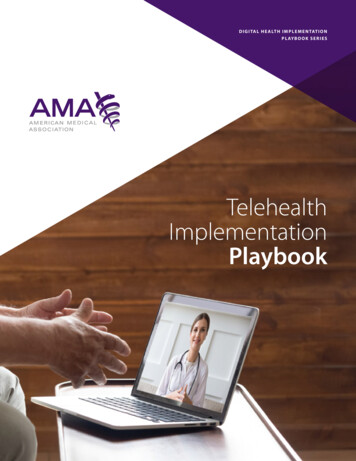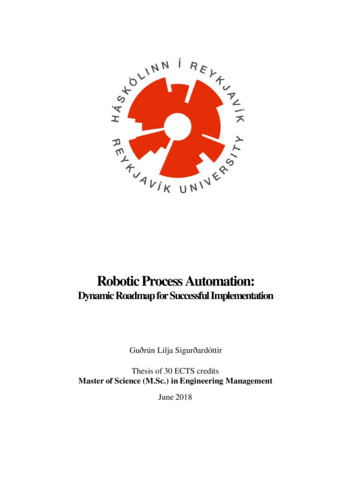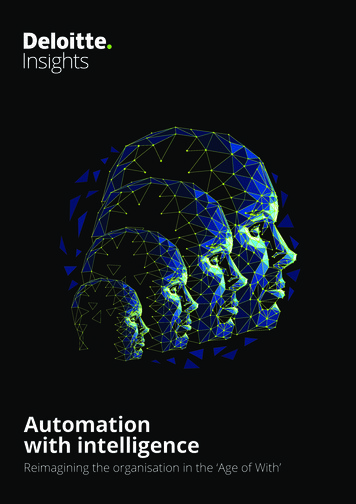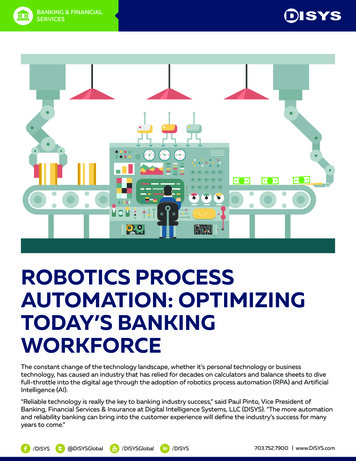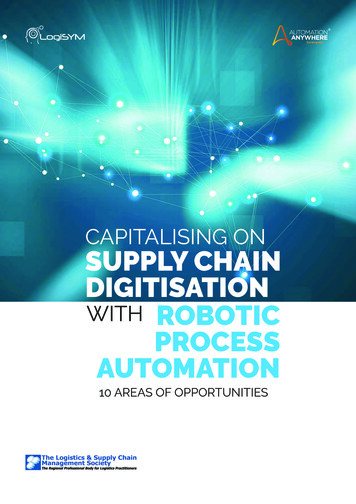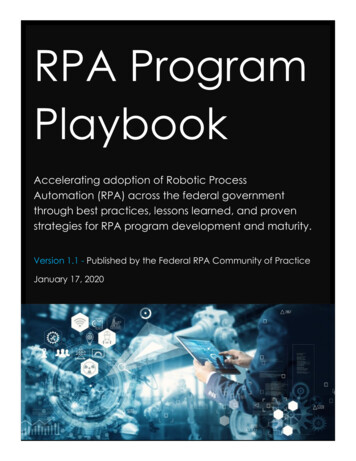
Transcription
RPA ProgramPlaybookAccelerating adoption of Robotic ProcessAutomation (RPA) across the federal governmentthrough best practices, lessons learned, and provenstrategies for RPA program development and maturity.Version 1.1 - Published by the Federal RPA Community of PracticeJanuary 17, 2020
LETTER FROM THE COP CHAIRFederal Community,We are proud to announce the initial publication of the Federal RoboticProcess Automation (RPA) Program Playbook. This playbook is designedto provide federal agencies detailed, accessible guidance for initiatinga new RPA program or rapidly evolving an existing program. We will periodically update this document to reflect developments in the federalRPA environment.The RPA Program Playbook aligns closely with the President’s Management Agenda’s (PMA) aggressive cross-government goal to “Shift fromGerard BadorrekLow to High Value Work” (CAP Goal 6). OMB is actively working, as part ofGSA Chief FinancialCAP Goal 6, to rescind and modify requirements and regulations that inOfficercrease agency workload. In addition to these burden reduction initiatives,another important element of CAP Goal 6 is workload elimination. All agencies are charged withpursuing workload elimination, and RPA provides a low-cost tool to make an immediate impact.The opportunity for RPA to transform federal operations is massive. Current RPA programs operating within agencies are achieving roughly five hours of workload elimination per employee. If thegovernment deployed RPA at scale and achieved only 20 hours of workload elimination per employee, the net capacity gained would be worth 3 billion - and that is only scratching the surface.Additional collaboration between agencies can help accelerate RPA adoption governmentwide, as agencies are currently wrestling with common implementation challenges in a vacuum.In publishing this RPA Program Playbook, the Federal Community of Practice (CoP) will facilitate agovernment-wide conversation to overcome these common challenges. This includes sharingbest practices and lessons learned from mature RPA programs, as well as resolving common technical, management, and operational issues.I would like to thank the RPA champions at DHS, NSF, NASA, OPM, HUD, GSA, FRB, Treasury, OMB,and throughout DOD (Army, OUSD, OSD) for their strong contributions to this playbook. Contributors are included at the end of the playbook, allowing readers to identify RPA champions withintheir agency. Feel free to reach out to these leaders to start implementing this exciting technologyimmediately.- GerardGerard BadorrekFederal RPA COP Chair and Executive Sponsor2
TABLE OF CONTENTSSection NamePage NumberPlaybook Introduction4RPA Program Technology10Technology Infrastructure13Security Policy20Credentialing Policy26Privacy Policy29RPA Program Management31Operating Model35RPA Program Design40Management Reporting and Business Value48Process Selection, Assessment, and Improvement55HR Planning and Impacts63Operations Management65Appendix69Note: The RPA Community of Practice developed this playbook with input from key federal RPA practitioners. This document should not be interpreted as official agency policy or mandated action.3
INTRODUCTION - RPA FUNDAMENTALSRobotic Process AutomationRobotic Process Automation (RPA) is a low to no-code Commercial Off the Shelf (COTS) technology thatcan be used to automate repetitive, rules-based tasks. Like an Excel macro operating within a spreadsheet, RPA can record actions performed across a personal computer, access systems, and perform delineated tasks for human users. RPA products vary in their exact capabilities, but all RPA technologies emulate human actions, enabling process owners or staff with appropriate training to rapidly design, test, anddeploy automations dramatically reducing an organization’s low-value workload. Popular uses of RPA include data entry, data reconciliation, spreadsheet manipulation, systems integration, automated datareporting, analytics, and customer outreach and communications.At a government-wide level, RPA can represent a profound change, with the potential to empower non-ITprofessionals and process owners with the tools to automate a significant share of their workload. RPA isconsidered transformative because it establishes the building blocks for artificial intelligence in terms of information technology infrastructure and task standardization. With effective RPA deployment, machinelearning and intelligent automation are only a few, manageable steps away.Many agencies across the federal government have initiated RPA programs to automate tasks of varyingcomplexity. Automations developed to date have focused on multiple functional areas including finance,acquisition, IT, human resources, mission organizations, and security/mission assurance. Each RPA program,created to identify, build, and deploy automations has adopted different structures and approaches,ranging from closely-governed centralized programs to decentralized initiatives.The benefits of RPA adoption within an agency can be significant. First, in alignment with the President’sManagement Agenda (PMA) Cross Agency Priority (CAP) Goal 6, RPA is an excellent tool for “Shifting fromLow to High Value Work.” Because RPA automates tasks, not jobs, it is primarily a tool for creating capacityand reducing organizational workload. This allows employees to focus on higher value-add work whiletheir ‘digital assistants’ perform the standard/repetitive work.RPA, however, is not just a workload reduction technology. It can be deployed to increase quality, reducehuman error, increase compliance, strengthen controls environments, and to add new services to an organization’s portfolio. For example, if an employee only has the bandwidth to audit a 10 percent sampleof transactions, an RPA automation, running 24/7, may be able to audit the entire data set and send noncompliant records for adjudication.From a government-wide perspective, the impact of wide-scale RPA adoption is massive. If agencies deployed RPA to save all civilian employees just 20 hours a year, that would equate to roughly 3 billion incapacity created. Some RPA programs within the federal government have already achieved 5-6 hours ofcapacity per employee within their agency, indicating a modest and achievable goal. Within a few yearsof focused RPA deployment, the federal government could see substantial progress on many of the Administration’s management goals in both terms of greater efficiency and greater ability to focus on highpriority initiatives.4
INTRODUCTION - PLAYBOOK CONTENTSThe Federal RPA Community of PracticeThe Federal RPA Community of Practice (CoP) is a thought leadership and collaborative body designed torapidly accelerate the adoption of RPA technology across the federal government. The CoP consists ofrepresentatives from more than 50 Federal agencies, with more than 750 members.The RPA CoP pursues a bifurcated mission. First, the organization is charged with discussing and designingsolutions to help individual agencies overcome the technical, management, and operational challengesthat arise in deploying an effective RPA program. This portion of the mission includes important initiativeslike designing common federal solutions for credentialing, privacy, and security, and designing commonmanagement metrics to gauge government-wide impact of RPA.The second element of the RPA CoP mission is to provide knowledge sharing and mentoring to organizations looking to start an RPA program or to evolve their current RPA services. This RPA Playbook is a smallpart of the CoP’s knowledge sharing efforts, which also include frequent cross-government collaborativemeetings, communications, thought leadership pieces, webinars, and workshops.The RPA CoP seeks to achieve its important mission with a sense of urgency and a bias towards action. Asagencies continue to learn the potential benefits of RPA, enthusiasm for developing RPA programs government-wide grows exponentially. The RPA CoP plays an important role in helping agencies convert RPA enthusiasm into action. Specifically, the CoP helps agencies develop programs that are cost effective, auditable, avoid common pitfalls, and most importantly, deploy impactful automations.5
INTRODUCTION - PLAYBOOK CONTENTSRPA Program PlaybookThis RPA Playbook gives federal agencies a detailed primer for initiating a new RPA program, as well asclear guidance for how to evolve existing RPA programs to achieve increased performance and maturity.Admittedly, this primer does not hold all of the answers for all of the challenges that arise on the RPA journey. To the extent answers can even be foreseen in advance, many of them will be agency-specific andnot applicable across government. Instead, this RPA Playbook identifies the major decision points andsteps along the journey and provides guidance based on best practices and lessons learned.The key guidance and themes of the Playbook are summarized below:1.Just Get Started - The CoP is definitely not recommending agencies jump into RPA without any planning. But once an organization has the proper initial planning in place, (goals, strategy, resourcing, RPAcandidates, and executive buy-in) they should get started and launch the RPA program. Leadershipmust then operate with the understanding that active and agile management will be required to identify and mitigate ongoing challenges.2.Ensure Effective Collaboration Between the RPA Program and the CIO - Agency CIOs playa critical role in creating a successful environment for RPA development, including the design of formalsecurity protocols, credentialing, privacy processes, procurement of technology solutions, and enterprise governance. A close, working collaboration between RPA program leadership and representatives of the CIO can expedite RPA throughput.3.Establish Aggressive Goals and Deliver - Similar to most new technologies, significant enthusiasm and excitement currently exists for the potential of RPA to transform federal agencies. It is important for RPA programs to quickly convert excitement into results, ensuring continued momentumand investment within agencies. Setting and communicating aggressive goals bolsters the ongoingbusiness case for RPA - it is an inexpensive and low complexity solution for many operating challengesnormally requiring expensive fixes such as system upgrades.4.Invest in Process Assessment and Improvement Capabilities - With the addition of strongprocess assessment and improvement capabilities, RPA can transform business operations within anagency. Process improvement expertise is a catalyst for impactful RPA, as it helps an agency optimizeRPA candidate selection and reengineer broad-scale business processes around the RPA application,increasing impact and value.5.Balance the Dual Priorities of Governance and Productivity - Establishing a Center of Excellence or other management mechanism to centralize and standardize RPA governance is an important milestone for maturing an RPA program. However, RPA program and agency leadership needto carefully balance the benefits of governance, controls, and SOPs (whether IT or management) withensuring high productivity and the deployment of impactful automations.6.Think Strategically about Technology Options - Currently, well over a dozen proven RPA specific technologies, as well as, a host of enterprise systems with add-on RPA modules exist in the commercial marketplace. Given the complexity of the federal procurement process, it is important to investtime and energy up front to assess technology options. Agencies should focus on identifying a low-costsolution from a stable provider best aligned with their long-term program needs (e.g. functionality, cost,security requirements, technology capabilities).6
INTRODUCTION - BENEFITS OF RPAWhy Deploy RPA at Your Agency?Federal agencies are under continuous pressure to do more with fewer resources. Federal mandates require agencies to pursue operational improvements, greater efficiencies, increased capabilities, and technology modernization. Program managers must determine how to marshal diminishing resources to meetcurrent workload and deliver on aggressive new federal and agency-specific requirements.Robotic Process Automation (RPA) should be a prominent addition to a savvy program manager’s toolkit. Reduced Implementation Time: RPA differs from traditional IT solutions in its ability to be rapidly designed and implemented. RPA automations are targeted solutions of limited scope and complexity.Because they mimic human interactions, costly business requirements analysis is not required. Moreover, because they are “low code” or “no code” solutions they require few technology resources. Program managers can obtain significant results in a matter of a few weeks or months. Increased Organizational Capacity: Because RPA automates tasks, not jobs, it is an effective means ofcreating additional capacity within your agency. Employees will be able to spend less time focusing onmanual tasks, and more time on high-value work like data reporting, analytics, and operational improvement. Moreover, RPA is an inexpensive means to increase throughput and overarching outputsfor critical business processes, allowing an organization to do more for customers and partners. Improved Employee Engagement: By automating manual, repetitive workload, organizations canachieve significant improvements in employee engagement. RPA automations increase employeequality of life by removing rote tasks, and enabling them to focus on critical activities. Qualitative Benefits: RPA deployments can achieve a host of qualitative benefits including: 1) increased accuracy; 2) increased compliance; 3) improved standardization and auditability; 4) lowerresponse times and increased customer satisfaction; 5) reduced process cycle times; and 6) increasedmeasurability and transparency. Applicability of RPA Across Functions and Agency Priorities: An investment in RPA technology canhave almost universal applicability across your organization. See the chart below for a brief descriptionon where RPA can be leveraged within your UNTABILITYAND AUDITDATA ANALYTICSAND REPORTINGCommon Use CasesCommon Use CasesCommon Use CasesCommon Use Cases Finance Systems Integration SOP Compliance Human Resources Transaction Reviews IT ServicesEnhanced SystemFunctionality (addons). Automated Controls Procurement CAP Management AdministrativeServices Risk Assessment andSurveying Data Verification andValidation7 Automated DataReporting Data Gathering andCleansing Data Mining PerformanceMonitoring
INTRODUCTION - COP MISSIONAccelerating Government-Wide Adoption of RPAFederal agencies are currently at multiple points in the RPA journey. A recent survey conducted by the Federal RPA CoP suggests there are roughly 25 organizations in the federal government that are piloting RPAtechnology or have a few automations in production. Approximately 10 more programs have 5 or more automations in production, and a further 5 programs have 20 RPA automations deployed.In designing this Playbook, the COP sought to provide support and guidance to all federal RPA partners —from those considering RPA, to those who have robust programs in place.The maturity model below represents the CoP’s thinking on how best to gauge the evolution of RPA programs and the types of indicators/milestones needed to convey agency progress in improving and growingRPA capabilities.The chapters in this playbook are dedicated to presenting best practices, lessons learned, and advice forhow every federal RPA program can climb the maturity ladder. Within these chapters, 10 capability areasare discussed in significant detail, providing readers with an understanding of how progress within these areas will lead to broader agency success in increasing RPA program maturity and value.RPA PROGRAM MATURITY MODELStart-Up RPAProgramEmergingRPA ProgramImpactful RPAProgramHigh-PerformingRPA ProgramLEVEL 1LEVEL 2LEVEL 3LEVEL 4 5-20 bots inproduction, 20 bots in production. 5-10 bots deployedmonthly. 5-50k hours ofannualizedcapacity created. 50-100k hours ofannualized capacity created. 100k hours of annualized capacity created. Formal ATO, IT Security and Privacypolicies. COE Model—bots generated from multiplebusiness units. Strong programand operationsmanagement. Intelligent automationcapabilities. Dedicated (FTE) program management,process reengineering,and developmentcapabilities. Pilot bots underway or 5bots in production.Less than 5khours of annualized capacity created.Establishingformal processes relatedto RPA. Initial security,privacy, andATO policiesformally defined.Developingprogram management, reporting, andprocess improvementcapabilities. Strong processimprovement capabilities. RPA solutions implemented acrossmultiple functionalareas. Workforce redeployment, capacity planning, and reskillingrequired. Robust pipeline offuture opportunities. Enterprise platform forunattended bots.8
INTRODUCTION - RPA PLAYBOOK CAPABILITY AREASRPA Capability AreasThe matrices below depict the 10 RPA capability areas an agency would need to address to progressalong the RPA program maturity model. For ease of reading, the capability area descriptions are truncated with full descriptions contained in each of the dedicated sections in the playbook.It is important to note the CoP is not recommending every agency progress from Level 1 to Level 4, sequentially, in all areas. For compelling business reasons, agencies may choose to skip Level 1 or Level 2 insome areas, particularly if the program intends to act as agency-wide RPA provider.RPA TechnologyCapability Area DescriptionMaturity ModelL1TechnologyInfrastructureSelecting, building, operating, and maintaining a secure and scalableIT platform for development, testing, and production.Security/ATODesigning streamlined Security/ATO processes to ensure safe and rapid deployment of automations.CredentialingDesigning compliant credentialing processes aligning with RPA program resourcing and technology strategies.PrivacyDeveloping processes to meet relevant federal privacy and ethicsstandards for the deployment of RPA.L2L3L4RPA Program ManagementCapability Area DescriptionMaturity ModelL1Operating ModelEstablishing an effective oversight and management framework tofoster cross-agency collaboration and accountability.RPA ProgramDesignDesigning an RPA program structure to meet established throughputgoals and deployment strategy.ManagementReporting andBusiness ValueCreating program-specific and government-wide RPA implementationand operations metrics, strategies, and business case models to drivecommon measurement and impact analysis.HR ImpactsDrafting HR processes and guidance to address the impacts of RPAincluding employee reskilling, redeployment, and satisfaction.ProcessAssessment andImprovementIdentifying and assessing processes for automation that maximize thevalue of RPA within an agency. Leveraging RPA effectively as a toolfor broad process improvement within an agency.OperationsManagementDefining processes for developing automations, scheduling automations, facilitating capacity management, license management, andmonitoring/fixing errors.9L2L3L4
SECTION 1RPA ProgramTechnology10
TECHNOLOGY OVERVIEW1. Technology Infrastructure2. Technology Policy Security Credentialing Privacy11
RPA MYTHBUSTERS - TECHNOLOGY EDITIONDispelling a few myths and misconceptions about RPA inthe federal government .There is one technology infrastructure strategy that all agencies should follow.1BUSTEDThe technology infrastructure strategy used for evolving from RPA pilot to highimpact program should be agency-specific and incorporate agency businessstrategy, RPA goals, resourcing levels, existing agency technology strategy, operational realities and structures, and program requirements (demand).No guidance exists for credentialing non-humans.2BUSTEDNo authoritative guidance exists for credentialing non-humans specific toRPA, but existing OMB, FISMA, and NIST directives speak to this issue from anautomation technology perspective. Multiple agencies have adapted thesesources to develop robust, safe, credentialing strategies for non-humanswithin the RPA context.Every RPA automation project requires a new Authority to Operate (ATO).3BUSTEDThe common security approval strategy is for the overarching RPA softwareor technology to receive a formal approval from the agency’s CIO/CISOand each automation project created using that software to complete alimited, lower-level, approval specific to its functionality.RPA will soon be out of date. Let’s just wait for AI.4BUSTEDRPA is an important stepping stone to AI because it establishes the right technology structures, technology competencies, organizational culture, andstandardized business processes to adapt AI. Transitioning from manual, repetitive, workload straight to machine learning or other advanced AI tools is oftena leap too far. RPA sets agencies on an effective path.RPA should never touch PII. It’s too risky.5BUSTEDMany agencies across the federal government are currently running RPAautomations that manipulate and store data containing PII. While this functionality does require an additional set of approvals, getting them is not aninsurmountable task, and most agency privacy officers already have clearprocedures in place for getting approvals to access and manipulate PII.12
TECHNOLOGY INFRASTRUCTUREMATURITY MODEL ALIGNMENTStart-Up RPA ProgramsEmerging RPA ProgramsImpactful RPA ProgramsLEVEL 1LEVEL 2LEVEL 3 Initial technology selectionDesktop model Enterprise softwareselectionVirtual desktop model Enterprise software deployment and infrastructureEnterprise platform modelLevel 1: Technology Infrastructure for Start-Up RPA ProgramsTechnology Selection for Start-Up RPA ProgramsTo select the most appropriate technology for an RPApilot, start with a firm understanding of initial proposedautomation opportunities. As detailed in the Process Selection section of this playbook, the pilot automationsshould be low complexity - meaning they should onlyinteract with a few systems, with consolidated ownershipand relatively few stakeholders.A full review of technical requirements for the future RPAprogram is not required at the pilot stage. However, theCoP does recommend RPA program staff assess the requirements of the pilot opportunity against vendor capabilities including cost factors, ease of use, technical criteria, and availability of vendor support.The program should also determine which vendor solutions may already be on the agency’s Technical Reference Model (TRM) or Software Product Listing (SPL) ofapproved technologies. Solutions already approved torun on an agency’s network(s) can be deployed withexpedited procurement and approvals processes. Mostagencies also offer a waiver process for pilot programsoutside the SPL or TRM List.Pilot Technology Evaluation Factors:1.Technical Criteria - includes agency-specificoperating system and hardware requirements, as well as the technical capabilitiesneeded to fully deploy the selected automation.2.Cost - includes initial setup costs, licensingcosts, and maintenance costs for the pilotautomation. Vendors can offer price incentives for testing and piloting technology.3.Ease of Use - includes the ease of coding/automation development and ease of interacting with systems relevant to the specificautomation opportunity.4.Vendor Support - most vendors offer ongoingsupport, training, and customer outreach toassist agencies in completing pilot bots. Thiswould be less critical if an agency were usingcontractor support to build the automation.Agency CIOs or technology management offices should be consulted throughout the selection process for the RPA pilot technology. These groups likely already have a formal process in place for evaluating potential vendors, existing contracts to expedite acquisitions, and the knowledge and infrastructure to help a start-up RPA program make a smart choice in selecting pilot technology.13
TECHNOLOGY INFRASTRUCTUREDesktop ModelApproach #1 - Desktop ModelDescription:Deploying attended automations using a“Desktop Model,” is the quickest path for astart-up RPA program to develop proof ofconcept. In the Desktop Model, the RPA solution leverages the processing power of onePros:workstation and one user’s credentials.When this model is used for a pilot project orproof of concept, the user generally startsthe automation employing his or her credentials to access enterprise networks and multiple systems on the desktop to gather dataSecurityand run the automation.In launching and designing the pilot program, it is recommended to work with theCIO shop for approval to download and access RPA software.The Desktop Model is best suited to running a pilotproject or proof of concept. While technically lesscomplex than other RPA infrastructure approaches,it lacks the scalability, functionality and controls tosupport a large RPA program. Low Investment RapidCons: Limited toAttended BotsImplementation Limited Scalability Low Financial Risk Audit/Security Risks Low TechnicalComplexityImplicationsSecurity and audit concerns - difficult to enforcestandardization, controls, or policies with desktopsoftware running on individual laptops.CredentialingImplicationsLow complexity - automations run using existing human credentials and user access to systems.PrivacyPrivacy concerns - data types and systems ac-Although this platform does not require signifi- Implicationscessed through the desktop model raise privacycant upfront investment in IT infrastructureconcerns and would keep the automation from(cloud or on-premise), it is limited in capabilever going “live.”ity because of challenges in scaling automations to larger user populations. Deploying attended automations run by process custodians must integrateseparation-of-duty controls that prevent the custodian from being able to alter automation coding.As an RPA program matures its technology infrastructure, these automations can easily be retrofitted anddeployed live using either the Virtual Desktop Infrastructure (VDI) or enterprise platform that provides oversight and tracking of automations.In sum, the Desktop Model is recommended for a pilot project because it gives the RPA program an opportunity to gauge the technical feasibility of the vendor solution, plan future operational costs, and measuretechnical capabilities against future requirements. Program leaders might also consider a related alternativeto the desktop model - RPA as a Service (RPAaaS). These offerings from several leading vendors and serviceproviders offer the speed and ease of the desktop approach while reducing security concerns because nosoftware is installed locally. One potential issue of RPAaaS to consider is on-network data and resources maynot be accessible from the public cloud services, so pilots may be limited to automations involving publicdata sources.Level 2: Technology Infrastructure for Emerging RPA ProgramsEnterprise Technology Selection for Emerging RPA ProgramsThere are currently numerous RPA technologies on the market, in addition to multiple Business Process Management (BPM) solutions with dedicated RPA modules. Deciding which of these solutions will best serve anagency’s RPA program can be daunting.14
TECHNOLOGY INFRASTRUCTUREBut if an RPA program has a clear long-term strategy and defined technical requirements, the assessmentand selection can be completed in as little as 6-8 weeks while work continues towards a pilot. In additionto reviewing technical capabilities, it is important to conduct vendor demonstrations that address primaryuse cases, and speak with references to ensure strong alignment with the preferred supplier.Agency CIOs have the expertise to help RPA programs align requirements with capabilities and should beable to help create a finite list of options for leadership. Agency enterprise architects can determine thebest strategy for selecting an RPA technology that fits into the overarching IT environment.The figure below provides a sample set of criteria to consider in making an enterprise technology selection. The agency CIO will likely have an existing process, as well as expertise and acquisition vehicles toassist the RPA program in identifying and procuring the optimal technology package.Factor 1: Vendor ExperienceFactor 2: Product Features - Process Market Presence Workflow Management Commercial Experience Process Recorder Public Sector Experience Self-Learning Capabilities Industry Recognition Ease of Use Customer References Contracting ConsiderationsProcess AssessmentFunctionalitiesFactor 3: Product Features - Automation Visual Authoring Tool Command Library Attended/Unattended Automation Capabilities Component Sharing Test/Debugging Controls Ease of UseFactor 4: SecurityFactor 5: Product Features - Operations Centralized Bot Deployment,Management, and Scheduling Application Security Credential Management FedRAMP Compliance ATO Experience Risk/Security Assessments Certifications Data Encryption/Protection Process TraceabilityFactor 6: Architecture Hardware/Software Requirements and Virtualized ServersLicensing Structure Multi-Tenant Support Volume, Scalability, andWorkload Management On Premises (Desktop/Server) Exemption/Exception HandlingCloud (Public/Private/ Hybrid) Dashboard CapabilityAvailability and Disaster Recovery Capabilities Business Analytics Network Bandwidth Impacts Operational Analytics15
TECHNOLOGY INFRASTRUCTUREVirtual Desktop ModelApproach #2 - Virtual DesktopSeveral leading agencies used a VDI to accelerate RPA adoption, complete pilot automations, and even deploy automations atscale. VDI can serve as a bridge betweenindividual desktop piloting and full enterprisesolutions. In order to get started with the VDImodel,
Jan 17, 2020 · Robotic Process Automation Robotic Process Automation (RPA) is a low to no-code Commercial Off the Shelf (COTS) technology that can be used to automate repetitive, rules-based tasks. Like an Excel macro operating within a spread-sheet, RPA can record actions performed acros

